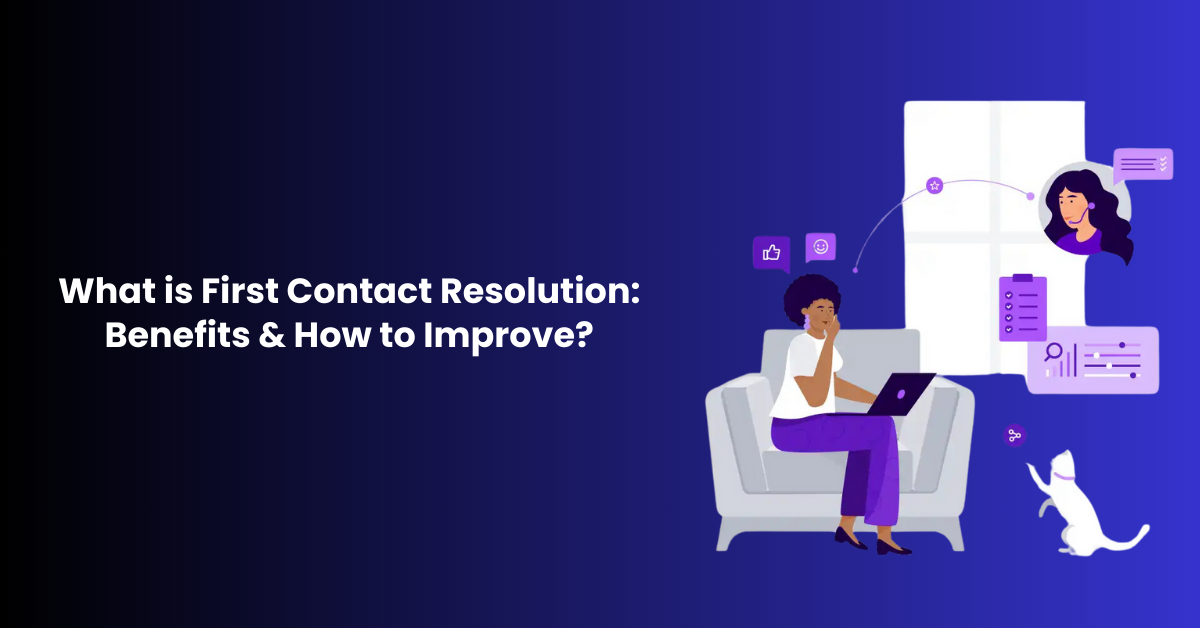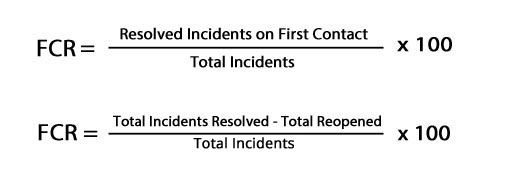What is First Contact Resolution: Benefits & How to Improve?

First Contact Resolution (FCR) is a crucial metric in customer service, measuring the rate at which customer issues are resolved during the first interaction. A study by Customer Contact Week found that a 1% improvement in FCR can result in a 1% increase in customer satisfaction. Understanding and enhancing FCR can significantly boost service efficiency and customer loyalty. This blog explores the benefits of achieving high FCR and offers practical strategies to improve it, ensuring customers leave interactions feeling satisfied and supported, without the need for follow-up.
What is First Call Resolution?

First Call Resolution (FCR) is a measure used in customer service to indicate how effectively a service team resolves customer issues during the initial interaction. A high FCR rate implies that customers are getting their problems solved quickly without the need for follow-up calls, emails, or further support. This metric is essential for assessing the quality and effectiveness of customer service operations. FCR not only enhances customer satisfaction by providing timely solutions but also improves operational efficiency by reducing the volume of repeat queries, saving time and resources for both the customer and the company.
First Call Resolution Formula

The formula for First Call Resolution (FCR) is calculated by dividing the number of customer issues resolved on the first interaction by the total number of first interaction calls. Multiply the result by 100 to express it as a percentage:
FCR (%)=(Resolved on First InteractionTotal First Interactions)×100FCR (%)=(Total First InteractionsResolved on First Interaction)×100
First Call Resolution Benefits
First Call Resolution (FCR) offers several significant benefits that can improve both customer satisfaction and operational efficiency in a contact center or customer service department. Here are some key advantages:
- Enhanced Customer Satisfaction: Customers appreciate quick and effective solutions to their problems. Achieving resolution during the initial interaction can significantly improve their overall satisfaction and perception of the company, reducing frustration from repeated calls about the same issue.
- Increased Customer Loyalty: When issues are resolved promptly, customers are more likely to have a positive view of the business, leading to increased loyalty and a higher likelihood of recommending the service to others.
- Reduced Operational Costs: Resolving customer issues on the first call reduces the need for follow-up calls, emails, or other contacts. This efficiency reduces the workload on customer service staff and decreases operational costs related to time and resources spent on repeated interactions.
- Improved Employee Satisfaction: Employees experience higher job satisfaction when they can resolve issues effectively and efficiently. This boosts morale and can reduce turnover rates, which is beneficial for maintaining a knowledgeable and experienced customer service team.
- Enhanced Service Metrics: FCR is a critical metric that impacts other performance indicators such as average handling time and customer effort score. A high FCR rate usually correlates with better performance in these areas, indicating a more efficient service operation.
First call resolution Best Practices
Improving First Call Resolution (FCR) is pivotal for enhancing customer service quality. Here are several best practices to consider:
- Comprehensive Training: Equip your customer service team with extensive training that includes not only product and service knowledge but also problem-solving skills. This preparation ensures they can handle a wide array of customer inquiries effectively on the first contact.
- Access to Information: Provide your team with easy access to all necessary information, such as customer history, product details, and support documentation. Using a unified database helps agents quickly retrieve all relevant data needed to resolve issues efficiently.
- Empowerment of Staff: Allow your customer service agents the autonomy to make decisions and provide solutions without needing excessive approvals. Empowerment speeds up the resolution process and enhances employee satisfaction.
- Feedback Mechanisms: Implement a system for capturing feedback from customers about their service experience. This data can pinpoint areas where the resolution process might be falling short and offer insights into how it can be improved.
- Regular Reviews: Conduct regular reviews of customer service interactions to ensure that quality standards are being maintained and to identify opportunities for improvement in the FCR rate.
- Technological Support: Leverage technology like CRM systems and AI tools that can assist in diagnosing customer issues and suggesting quick solutions, thus aiding agents in achieving FCR.
How to Improve First Contact Resolution?
Improving First Contact Resolution (FCR) is essential for providing effective customer service and enhancing customer satisfaction. Here are practical steps to improve FCR in your organization:
- Enhance Training Programs: Develop comprehensive training sessions that cover all aspects of your products, services, and customer handling skills. Ensure that all customer service representatives (CSRs) are updated with the latest product information and troubleshooting guides. This preparation enables them to handle inquiries confidently and competently right from the first interaction.
- Utilize Robust Knowledge Bases: Create and maintain a detailed knowledge base that is easily accessible to CSRs during calls. This should include FAQs, troubleshooting steps, product details, and previous customer interaction logs. Having this information at their fingertips allows agents to provide accurate and prompt solutions.
- Implement Advanced Call Routing: Use technology to route calls to the most appropriate CSR based on the nature of the inquiry and the agent’s expertise. This targeted approach reduces the time spent on transferring calls between different departments and increases the chances of resolving the issue in the first interaction.
- Empower Your Team: Allow CSRs the authority to resolve issues without needing to escalate them. Empowerment can significantly speed up resolution times and improve the overall efficiency of your customer service team.
- Gather and Act on Feedback: Regularly collect feedback from customers regarding their experience. Analyze this data to identify common pain points or recurring issues. Use these insights to refine your processes and training, ensuring continuous improvement in your FCR rates.
- Monitor and Reward Performance: Regularly monitor FCR rates and other related metrics. Recognize and reward CSRs who consistently achieve high FCR. This not only motivates your team but also sets a benchmark for others to aim for.
Handle your Customer Support with AI

Incorporating Manifest AI into your customer support operations can transform how you engage with and serve your customers. Manifest AI leverages advanced AI technology to streamline communication and enhance the support experience. Here’s how it can be effectively integrated:
- Automated Response Handling: Manifest AI can manage routine customer inquiries with precision and speed, allowing your support team to focus on more complex issues. This improves efficiency and reduces response times, which are critical for customer satisfaction.
- Personalization at Scale: By analyzing customer data, Manifest AI tailors interactions based on individual customer preferences and history. This personalization ensures that customers feel understood and valued, which is essential for building long-term relationships.
- Real-Time Assistance: Manifest AI operates around the clock, providing immediate help whenever customers need it. This 24/7 availability ensures that your business is always responsive, significantly enhancing customer trust and reliability.
- Continuous Learning: As Manifest AI interacts with customers, it gathers insights and adapts to provide better service over time. This learning process continually refines its ability to handle queries more effectively.
Conclusion
First Contact Resolution (FCR) is a critical metric for evaluating the efficiency and effectiveness of customer service. Achieving a high FCR rate not only boosts customer satisfaction but also enhances operational efficiency by reducing repeated interactions. By investing in comprehensive training, employing robust knowledge bases, and leveraging technology such as advanced call routing, businesses can significantly improve their FCR. Emphasizing continuous learning and feedback will ensure that your customer service team consistently meets and exceeds customer expectations, fostering loyalty and trust in your brand.

.png)
